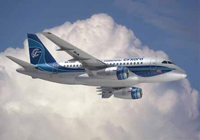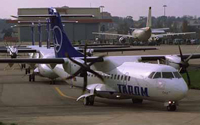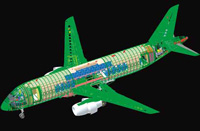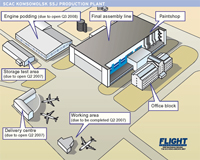Sukhoi Superjet 100
 Originally known as the Russian Regional Jet, which was proposed in three models and six variants, the RRJ-60, RRJ-75 and RRJ-95; the aircraft was renamed as the Superjet 100 at the Farnborough air show in July 2006, at which time 60-seat model was dropped from the line up.
Originally known as the Russian Regional Jet, which was proposed in three models and six variants, the RRJ-60, RRJ-75 and RRJ-95; the aircraft was renamed as the Superjet 100 at the Farnborough air show in July 2006, at which time 60-seat model was dropped from the line up.
The remaining Superjet models, the 100-75 and 100-95 are the first Russian airliners designed from the outset to meet Western certification standards.
The aircraft is being developed by a Sukhoi Civil Aircraft Company (SCAC)-led team which includes Alenia (with a 25% +1 share stake in the programme), Beriev and Yakolev.
Boeing advised on marketing, certification and customer support and agreements have been signed with risk-sharing partners in the West, including; B/E Aerospace, Dowty, Goodrich, Hamilton Sundstrand, Honeywell, Liebherr, Messier-Dowty, Parker.
The 100-75 can accommodate 75 passengers in an all economy class, 5-abreast configuration at 32" seat pitch, complete with a forward galley and 2 lavatories. In a typical two-class configuration, 68 passengers could be accommodated, comprising 10 in business class, four-abreast at 35" pitch and 58 in economy class, five abreast at 30" pitch, complete with a forward galley and 3 lavatories. Basic model Superjet 100-75s will be powered by Powerjet's modular SaM146 powerplant rated at 60.05 kN (13,500 lbst) take-off thrust.
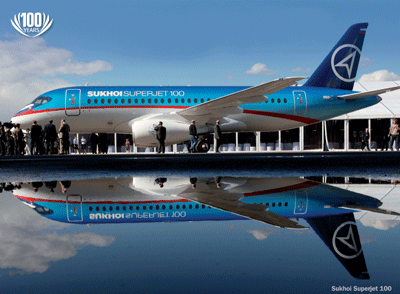
Sukhoi Superjet cutaway
Aircraft Data for the SSJ
Principal Dimensions Overall length: 26.33 m
Wingspan: 27.80 m Height: 10.28 m Cabin height: 2.13 m Cabin width 3.23 m Weights Maximum takeoff weight: 38,820 kg Maximum landing weight 35,000 kg Performance Max range: 3,361 km Typical passenger capacity: 2+68 Maximum passenger capacity: 2+78 Max Ceiling: 40,000 ft Powerplant: 2xSaM146
SSJ aircraft articles from flightglobal
SSJ aircraft articles from the web
Flight's products
Flight's commercial aircraft directory online
Flight's commercial engine directory
Sukhoi Superjet 100 special features
Source: Flight International






















